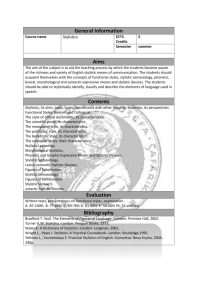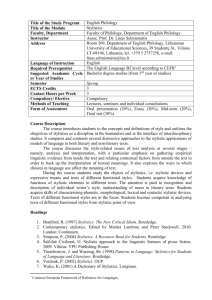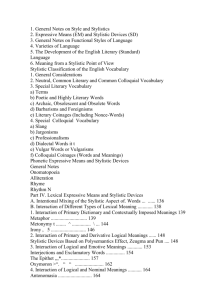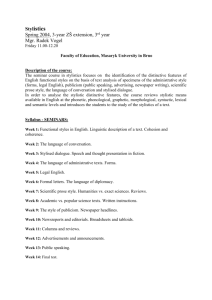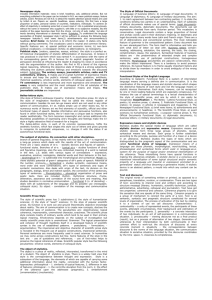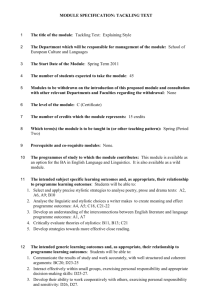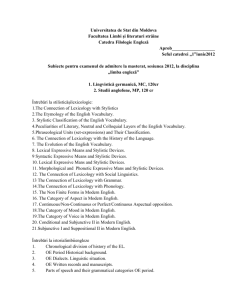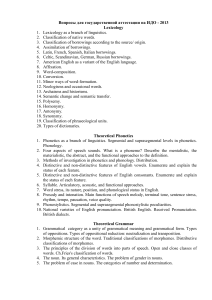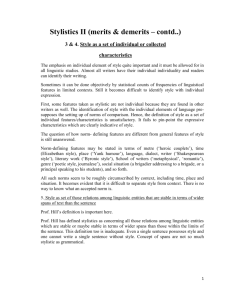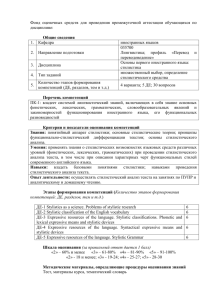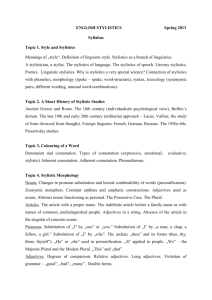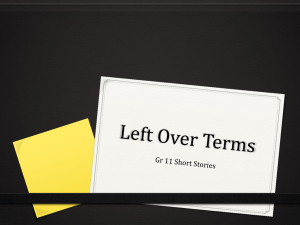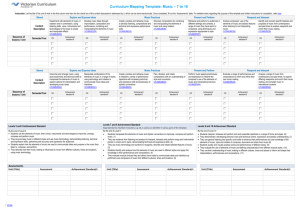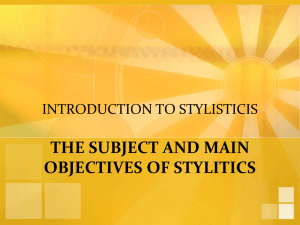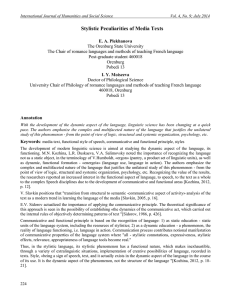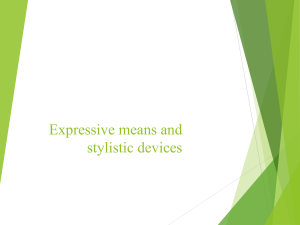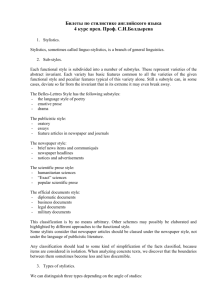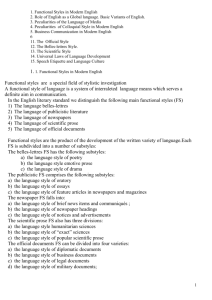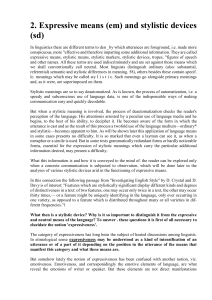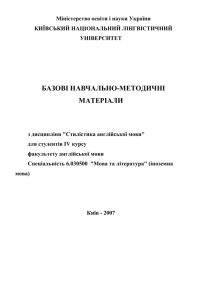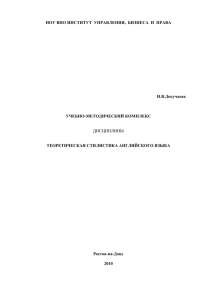KHAZAR UNIVERSITY
advertisement
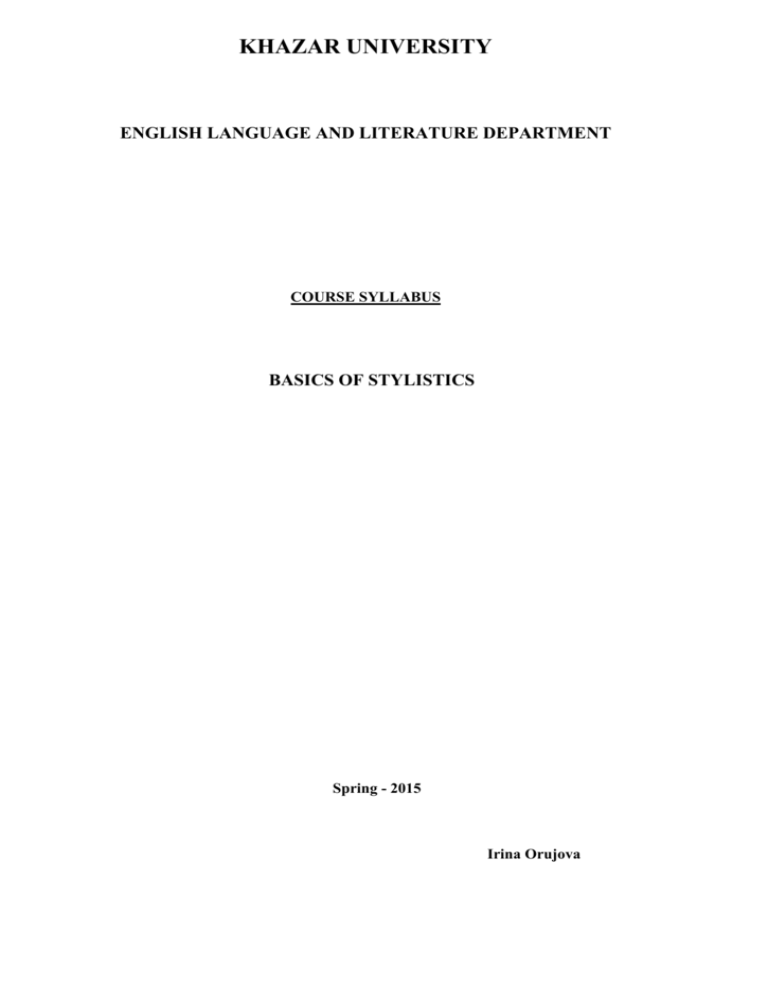
KHAZAR UNIVERSITY ENGLISH LANGUAGE AND LITERATURE DEPARTMENT COURSE SYLLABUS BASICS OF STYLISTICS Spring - 2015 Irina Orujova Number of Credit Points: 3 Number of Hours per Week: 4 Instructor: I. Orujova Course books: 1. I.R. Galperin. Stylistics. Moscow, 1977 2. V.A. Kukharenko. A Book of Practice in Stylistics. Moscow, 1986 3. И.В. Арнольд. Стилистика современного английского языка. Ленинград, 1981 Additional books: 4. V.A. Kukharenko. Seminars in Style. M., 1971 5. Mick Short. Exploring the Language of Poems, Plays and Prose. Longman, 1996 6. G. Leech, M. Short. Style in Fiction. Longman, 2007 Pre-requisites: Introduction to Linguistics, Grammar Advanced and Pre-Advanced, ESL Course Description: The course is a part of general science about language – Linguistics. It is designed for intermediate to upper – intermediate students majoring in Translation Studies and Teaching English and Literature as a Second Language. It provides the students with the comprehensive notion of the main phonetic, lexical and syntactical expressive means and stylistic devices necessary for such interrelated courses as Creative Writing and Academic Writing. It also focuses on gaining practical skills in finding and using such devices in the original texts. The variety of expressive means (EM), stylistic devices (SD) and other elements of style, such as the diversity of functional styles of the English language and of stylistic layers of the English vocabulary will be analyzed during classes. The insight into the number of frameworks of linguistic choices and strategies that can be used in various genres of texts will also be presented. For this purpose the texts from a number of different genres will be discussed. Course Objectives - Introduce the students to the framework of stylistic analysis - Gaining the knowledge of expressive means (EM) and stylistic devices (SD), functional styles and stratification of vocabulary and their characteristic features - Make the students familiar with current research in the field of Stylistics Course Requirements 1) Preparing the readings carefully for each class meetings and coming prepared to discuss issues arising from the readings 2) Participating actively in class discussions and analysis 3) Handing in assignments on time, making planned presentations and writing mandatory quizzes Learning Outcomes At the end of the semester the students are expected: - to be able to distinguish the major stylistic devices and expressive means within the framework of the various texts belonging to different functional styles; - to distinguish between the functional styles of the texts and provide the information on the characteristic features of them; to be able to provide an extensive analysis of the texts, bearing in mind the functional style, stratification of the vocabulary, and expressive means and stylistic devices. Attendance Policy: For every two unexcused absences, one (1) point will be deducted from the grade point average. Students must arrive at class on time and remain for the entire period unless they are suddenly ill or have notified the instructor before the class that they will need to leave early. Frequent tardiness will not be acceptable. Academic Dishonesty: Plagiarism and cheating are crimes and will be severely penalized, including the expulsion of a student from the university. Grading Scale: 100% - 90% - A 89% - 80% - B 79% - 70% - C 69% -60% - D 59% - below – F/1 Course Grading: Class Participation Activities Quiz Mid-term Exam Final exam 10% 10% 10% 35% 35% Wee ks I Dates Contents Support material 26-30 Jan./ Feb. 2-6 Feb. The Subject of Stylistics. Stylistics of Language. Stylistics of Speech. 9-13 Feb. Meaning from a Stylistic Point of View. Varieties of Language LG pp.3-6 16-20 Feb. Stylistic Classification of the English Vocabulary. Neutral, Common Literary and Common Colloquial Vocabulary. Special Literary Vocabulary. Terms, Poetic, Archaic, Obsolescent, Obsolete words, Barbarisms and Foreignisms. Special Colloquial Vocabulary. Slang, Jargonisms, Professionalisms, Dialectal Words and Vulgarisms. LG pp. 7-9 9-13 March Functional Styles of the English Language. General Classification. LG pp.15-17 VIII 16-20 March Functional Style of English. Characteristics of the Functional Styles of the English Language. LG pp. 17-22 IX 23-27 March 30-3 March April II The Notion of Style. Expressive Means (EM) and Stylistic Devices (SD) Lectures by Galperin (LG) pp. 1-2 LG pp. 2-3 Hrs 4 4 III IV V 23-27 Feb. VI 2-6 March 4 4 LG pp. 9-11 4 LG pp. 11-14 4 VII X XI 6-10 April XII 13-17 April XIII 20-24 April 4 4 Mid – term examination 4 Phonetic Expressive Means and Stylistic Devices. Onomatopoeia, Alliteration, Rhyme and Rhythm. Lexical Expressive Means and Stylistic Devices. Interaction of Different Types of Lexical Meaning. Interaction of Dictionary and Contextual Meaning. Metaphor, Metonymy, Irony. Interaction of Other Types of Lexical Meanings. Pun, Zeugma, Interjections and Exclamatory Words. Epithet, Oxymoron, Antonomasia. Intensification of a Certain Feature of a Thing or Phenomenon. Simile, Periphrasis, Euphemism, Hyperbole LG pp. 23-25 LG pp. 28-32 4 Peculiar Use of Set Expressions. Cliché, Proverbs and Sayings, Epigrams, Quotations and Allusions. LG pp. 32-35 4 4 LG pp. 25-28 4 27-1 April/ May Syntactical Expressive Means and Stylistic Devices. Supra – Phrasal Units. The Paragraph. Stylistic Inversion. Detached and Parallel Constructions. XV 4-8 May Repetition , Enumeration, Suspense, Climax, Antithesis, Asyndeton, Polysyndeton, Ellipsis, Represented Speech, Litotes and Rhetorical Questions XVI 11-15 May XIV Final examination LG pp. 35-38 4 LG pp. 38-44 4
